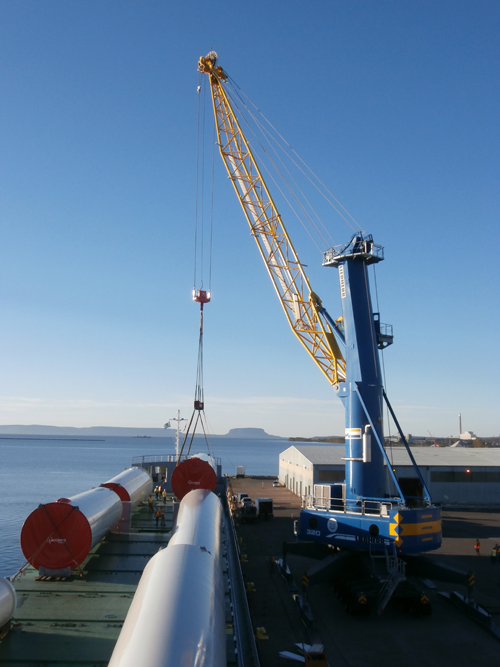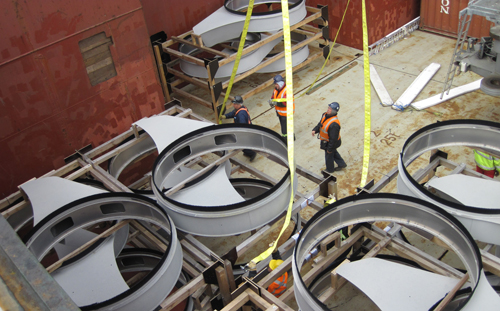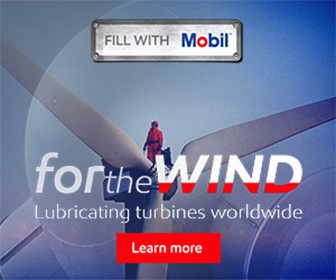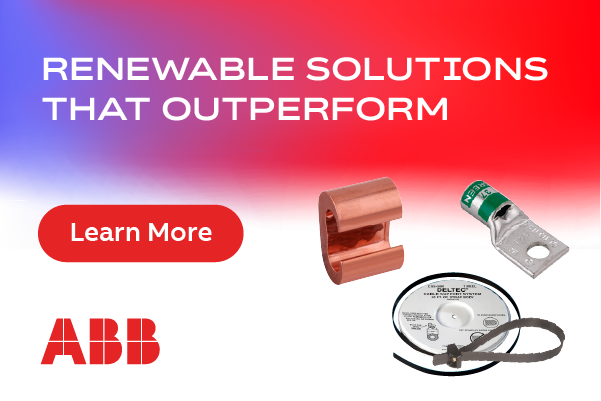Meeting Cargo-handling Challenges: Transporting wind energy components
 Wind turbines can have over 8000 parts, sourced from manufacturers throughout the world. If assembling all of those parts can sound like a challenge, just imagine arranging the transportation of them across cities, states, and often countries. Delivering the blades, towers, turbines, nacelles, hubs, and all of the many other nuts and bolts and components required isn’t always an easy task—particularly, considering most wind power farms are located in remote locations that aren’t always quick or simple to access.
Wind turbines can have over 8000 parts, sourced from manufacturers throughout the world. If assembling all of those parts can sound like a challenge, just imagine arranging the transportation of them across cities, states, and often countries. Delivering the blades, towers, turbines, nacelles, hubs, and all of the many other nuts and bolts and components required isn’t always an easy task—particularly, considering most wind power farms are located in remote locations that aren’t always quick or simple to access.
Most manufacturers use shipping agents, freight forwarders, or in-house logistics experts to find the right ports and transportation methods to efficiently move their merchandise. The role of a cargo-handling firm is to help ensure the quality and safety of that move, while ascertaining that the products shipped reach their final destination in flawless condition. After all, wind components shipped aren’t only numerous in quantities, but they’re typically oversized and distinctively shaped, often making logistics and transportation a unique and significant planning process.
Cargo handling professionals help customers choose the best routes, ships, and carriers for their particular product. They can add value to this process by managing the operational details when, for example, transitioning cargo from one point in the logistics chain to another.
A reputable transportation and logistics company should be able to provide answers to questions, such as:
- What is the best way to pack/stow goods, so they don’t shift during transport?
- How will the goods be transferred from one mode of transportation to another (i.e. from truck to rail or port to ship)—undamaged, and without compromising personnel safety?
- What regulations or cross-border legislation must be adhered to (and what papers or request forms must be filled out prior to shipping)?
- How can shipping deadlines best be met (and at reasonable costs)?
- Is product insurance necessary when shipping?
Safeguarding shipments
Many wind energy components are made of carbon fiber and lightweight alloys. They’re prone to damage from being bumped and coming into contact with other pieces of cargo. Dents or scratches could mean the difference between delivering on time, or sending components back to the factory for costly repairs.
The extensive scale of many new wind farms also means that larger shipments are on the move. In some cases, individual pieces have doubled in size over the past 10 years. The growing size and weight of the components themselves has been a challenge for the cargo handling industry. Modern wind cargo often requires large, flat open-space or “laydown” areas, so that various components can arrive separately (often weeks apart, and from different origins), but leave port together (usually by rail or in a convoy of specially designed flatbed trailers).
“When I started, blades were 15 meters long and now they’re up to 50 meters. Nacelles have grown from 30 tons to 110 tons, and we recently worked with 70-ton towers,” shares Anthony Steele, a cargo operations’ manager in Halifax, Canada, who says that even with the right equipment, these type of shipments require specialized rigging and experienced operations’ staff. “For example, blades are meant to cut through the air, and we need to compensate for that—keeping them stable when lifting from inside a ship, and across 10 to 12 meters to rest on a concrete terminal.”
The cost of transportation
 Cargo-handling companies and port authorities have adapted to meet the demands of the wind energy industry by investing in cranes, slings, and spreaders, which are specifically designed to hoist colossal items from within the confines of a ship’s hold and position them precisely for delivery to the final construction site. In some cases, permanent heavy-lift cranes have been installed as part of a terminal’s infrastructure, while other ports have mobile cranes on standby.
Cargo-handling companies and port authorities have adapted to meet the demands of the wind energy industry by investing in cranes, slings, and spreaders, which are specifically designed to hoist colossal items from within the confines of a ship’s hold and position them precisely for delivery to the final construction site. In some cases, permanent heavy-lift cranes have been installed as part of a terminal’s infrastructure, while other ports have mobile cranes on standby.
“Permanent cranes are more expensive upfront for the service provider, but the decreased mobilization costs can translate into savings for the customer,” explains Vasko Popovic, a cargo manager in Ontario, Canada. “In other cases, bringing in mobile equipment from another location means higher mobilization costs, but the port’s proximity to the customer’s end-market is such that savings come elsewhere.”
Ideally, Popvic says, that a cargo-handling partner should have enough locations in their portfolio to tailor a solution that’s right for a customer’s needs. He works in Thunder Bay, Ontario, which has been handling wind project cargo since 2001—making it one of the first ports along the Great Lakes to do so. In addition to ample laydown area, the port has access to equipment such as a Liebherr 320 crane, and is serviced by CN and CP railways.
This Ontario port is an effective gateway to move components from the east coast to western Canada, or from Canada to the United States (or vice versa). A ship’s cargo can be loaded directly onto a train, ensuring it spends as little time on the road as possible before reaching its destination—as was the case fairly recently for 34 units headed to Dawson Creek, British Columbia, including nacelles, hubs, and blades.
Interesting, the west coast isn’t the only part of Canada that’s seen an increase in wind-related shipments. In the east, the Maritimes have experienced a rather large increase in wind cargo over the past two years. The Port of Halifax has been stringently working with nacelles and hubs, loading them for rail transport because of their shape and weight. In Sheet Harbour, a sister port to Halifax that’s located about two hours away, blades and towers are being discharged to a 12-acre laydown area adjacent to the wharf. Or, when possible, they’re loaded directly to trucks and trailers because of the site’s convenient highway access.
Wind components are worth millions of dollars, so it’s important to work with a knowledgeable cargo-handling company that not only uses the right equipment and techniques, but also with one that’s aware of the fastest and most efficient ports and modes of transportation available. Most wind power projects have tight deadlines, and shipping shouldn’t get in the way of project success.
Logistec Stevedoring Inc. | Logistec Arrimage Inc.
www.logistec.com
Author: Emily Toms
Volume: September/October 2014









